10 Questions New Teachers Should Be Asking
Q&A Crash Course for New Teachers
I often go speak to pre-service teachers at Western Michigan University in Kalamazoo, MI. It is right down the road from my school building, and I love answering questions about teaching. It makes me a bit giddy. However, I have started to realize over the years that I am answering the same questions and some questions-that are really important-never come up. I wanted to make a post to outline the questions that I think new teachers should be asking before they step foot into a classroom, and then offer some words of advice or encouragement about each question. The post shows the 10 questions that I think matter to pre-service teachers and new teachers in the field. The hope is if we start having the conversations now with new teachers, the hard parts of teaching won’t catch anybody off guard. The goal is always for teachers to keep teaching, even when we think it is impossible.
When I was recently speaking to a group of pre-service teachers, the professor asked me a great question: “What three words would you use to describe the perfect intern?” My three words were:
Adaptability
Curiosity
Love
These three words really shape who I think all teachers should be. Yet, the field often makes each of these actions difficult. We get tired of being so adaptive. We grow exhausted at the constant craving for curiosity and ultimately want mastery. We find that love isn’t always easy when learning gets difficult. This can be love for the content, love for student lightbulb moments, or even love for the impact that is teaching young people. When we lose sight of these three objectives, we become tired and weary. I have written heavily on the topic of teacher burnout and the need for self-care in the teaching profession quite often on the blog. It is my hope that with a sense of adaptability, curiosity, and love, that I offer some answers to the questions new teachers might ask.
What would your three words be to describe a great teacher?
How will I manage the paper load?
I thought this question was impossible for most of the years I have spent teaching. I have a crate on wheels that has taken pounds of paper home over the years. I have spent Friday nights, Saturday nights, and Sundays (all day) trying to figure out a routine. The best grading advice I ever have kept with me is from Angela Watson and her blog, Cornerstone for Teachers. She encourages teachers on her podcast to set a working hour goal, and then stick to it. For example, on Sunday, my goal would be to work for 3 hours. After those 3 hours are up, I need to be done. No matter what.
The “no matter what” part is the hard part. Because ultimately, the management of paper is all about your mindset. What I mean by this is you have to be okay getting only a portion of your to-do lists done each week. They are never-ending; continual. I wish someone would have told me that I would never be caught up, so I could go into teaching with a different mindset about managing the paper load. I think I spent the first 5 years obsessing over my to-do list. Some things I have tried when it comes to the paper load:
to reduce the number of paper assignments given (utilize technology, focus on discussion, keep papers in a binder or portfolio that stays in class)
to streamline methods in class so I am more efficient (hop-checks, participation)
to set a time to work after school and then leave with no papers at a designated time (students leave at 2:30, grade from 2:30-4)
to set goals for grading on the weekend with time limits or try Pomodoro work techniques
to collaborate with others on grading techniques that are working
to research strategies that others use to tackle the paper (Rubrics, comment codes)
Use plan time at school more efficiently (even wearing earbuds as a clear signal of working)
Revisit grading systems as necessary to check-in with fair practices
Even the small strategies like writing the graded score next to the name of the student or keeping a blank roster to enter grades as they appear in the grade book are small things that can make the inputting of grades that much easier. You don’t learn these techniques until you get comfortable grading multiple stacks of paper. The constant goal is to streamline the process and maintain a high level of feedback.
Read:
What does the curriculum look like? How do I “fit everything in?”
English teachers are a special kind of people that teach both reading and writing; however, all teachers struggle with “fitting it all” in. The beginning of this process is in whatever curriculum guide you receive (or don’t receive) from your district. Some pacing guides are really detailed and strict on daily objectives and unit objectives, and some pacing guides leave everything up to individual teacher discretion. Your curriculum will have non-negotiables, and you will need to decide what are your own non-negotiables as well. My non-negotiables include daily choice reading, library usage, mentor text work, Friday creative free writing, and a weekly read aloud.
Make sure you understand:
What are my anchor texts? Supplementary texts?
What resources and materials are available?
What is the end goal of the unit?
How will you assess learning? Formative assessments? Summative assessments?
What are the key learning objectives (skills) I want students to gain by the end of the unit?
What areas of grammar will be reviewed?
What vocabulary words are needed to understand the work?
I often see pre-service teachers make these long, detailed unit plans. I think it is important to do this once or twice to really understand the role of curriculum design, but this action is not involved in my day-to-day teaching. We are always working toward the end goal in terms of reading goals and writing goals. I spend the most time with my formative assessments. It is the daily check-ins that lead to the big, summative goal.
Read:
How do I make lesson planning easier?
Once you understand the unit design, lesson planning is the fun part. I have included my format below in case you would like to use my Google Doc as a template. I make my lesson plans into a hyperdoc. Jennifer Gonzalez from The Cult of Pedagogy informs us about hyperdocs in her blog post, “How HyperDocs Can Transform Your Teaching.” Jennifer explains how this can be a powerful teaching tool, but more so, I like to use the concept when making my lesson plans. All of the links to all of my resources are in one place. I spent 10 years trying other methods that included: online lesson planning books, Google Docs for each week, writing the plans out first and then typing them, etc. I have tried every method of planning. I am most satisfied with this one because the unit plan and the weekly plans are on the same document, and then I can hyperlink all of my resources in one place. This method may not work for you. I encourage you to try what works best and takes up the least amount of your time outside of school.
Considering actual planning time, I know some teachers that do all of their planning on the weekend (like me) while others do their planning each day or during the workweek. Find what works for your life. I know that I sometimes struggle to wake up on time, so it brings me peace of mind to do all of my planning on the weekend. I know that there is a plan in place each day. If I am rushing to work, it will still be okay. I may do some mid-week tweaking of the plan, but overall, I follow what I put down over the weekend. Find the flow of planning time that works for you. Break it into manageable chunks and stick to those chunks. My mentor teacher told me that I can never have enough backup plans. This was good advice; however, I took it literally. I became obsessed with making sure I had multiple plans for the same lesson. Try to spend time reading as much as possible to make sure your strategies are grounded in observation and research. Then, you won’t worry as much or doubt yourself when you try out a lesson. I find it is important to give your first lesson idea a chance before you throw it into the garbage.
Here is a link to the Google Doc HyperDoc lesson plan template I am using now.
How do I set up the physical space of my classroom and establish routines at the beginning of the year?
If you walk into my room, you will notice that the walls are full. However, each space has a distinct purpose in my classroom. Here are the main physical areas of my classroom that are essential to the routines each day:
Classroom library with clipboard checkout system and return system on the bookshelf
Student materials center. This is where they get their pencils, sharpen pencils, get the lined paper, hand sanitizer, and tissue. It is where my turn-in bins are located to receive student work, and it is also where I keep bins for work to pass back to students. All of this is away from my desk. I forgot who said this, but it has stuck with me over the years. To paraphrase, “Don’t get mad about students in your desk area if you are keeping materials they need near to your desk.” Everything they need is not located in my desk area.
Homework folders/Bulletin board with directions. I like to keep a bulletin board with directions on how to complete homework nearby so when I get new students I can easily explain how homework works in my classroom.
Claim your no-name papers on the clothesline on the windows. Some teachers don’t keep no-names, some do. I keep them for the unit, and then I recycle. I also make sure I don’t grade the no-names before posting to avoid temptation for someone who hasn’t completed the assignment.
Agenda posted on the board. This includes date, reminders, precept or quote for the week, agendas for all of my classes (two preps this year), and the mentor text sentences.
Binders and journals for all classes are on wall shelves. This makes sure that each class has its own area. They keep all of their work in binders with a table of contents, and they keep their class writing journal in a crate.
Each area of my classroom has a purpose and use. Each classroom feeds into an instructional routine that we complete on a daily basis.
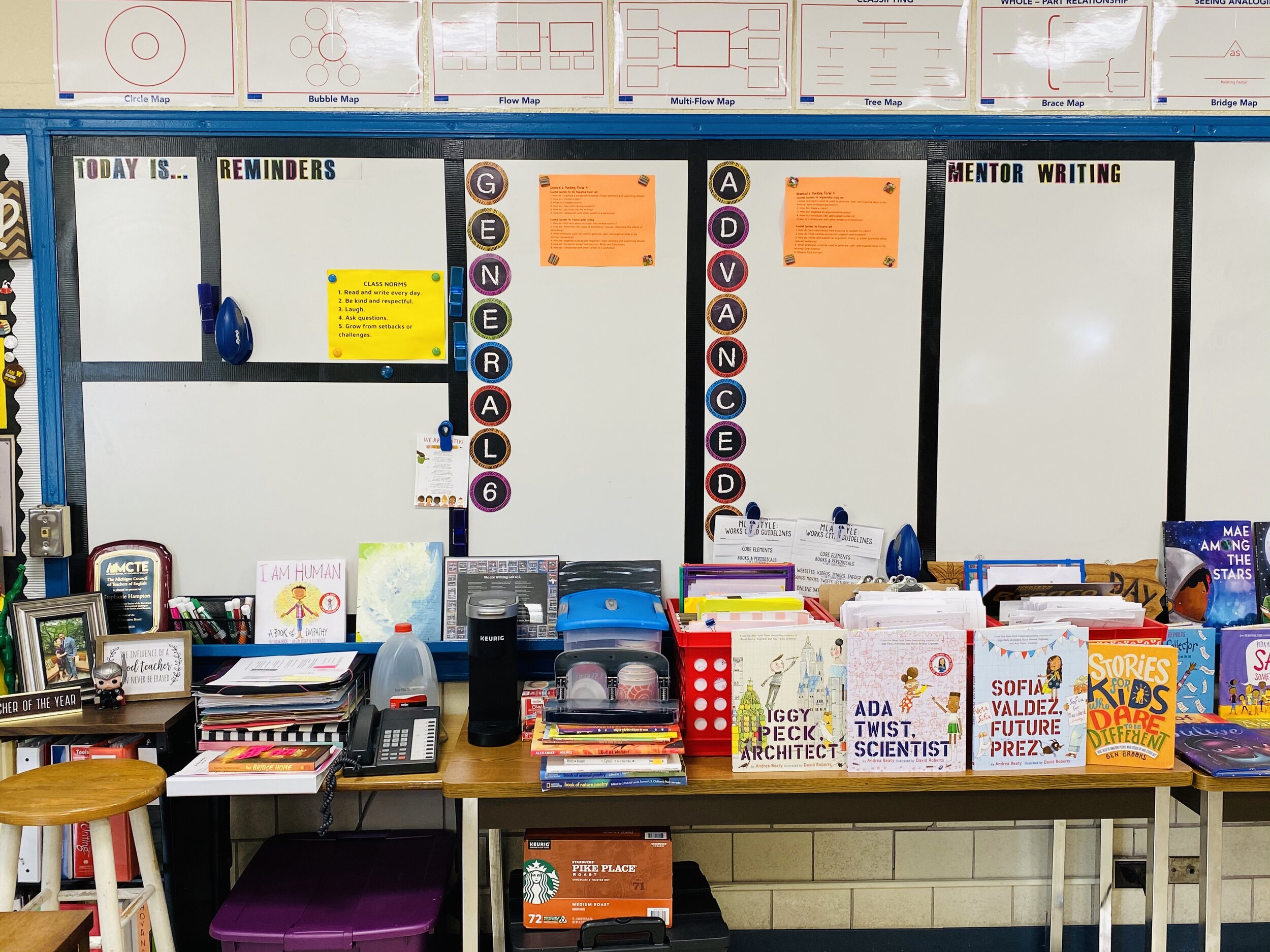
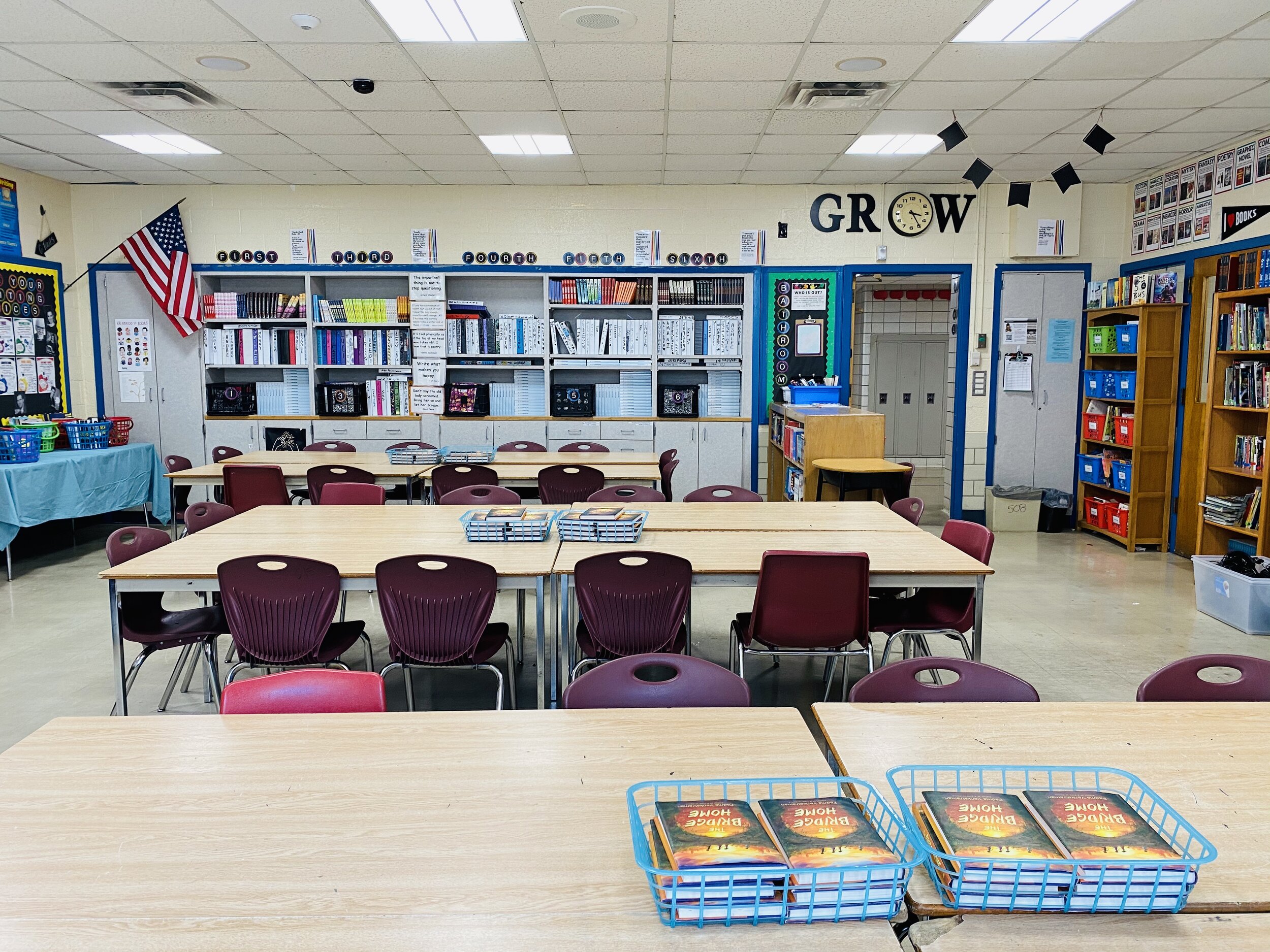
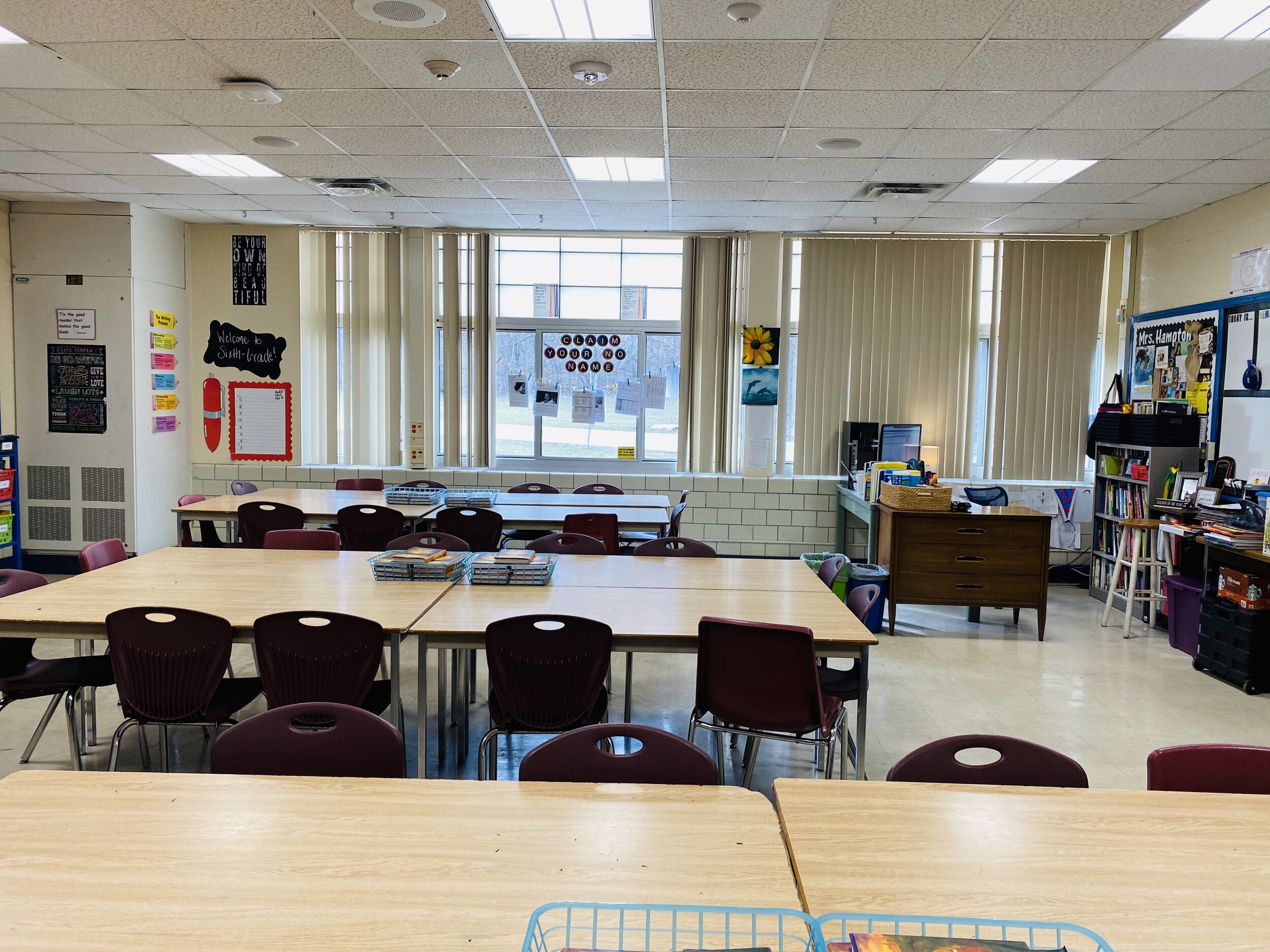
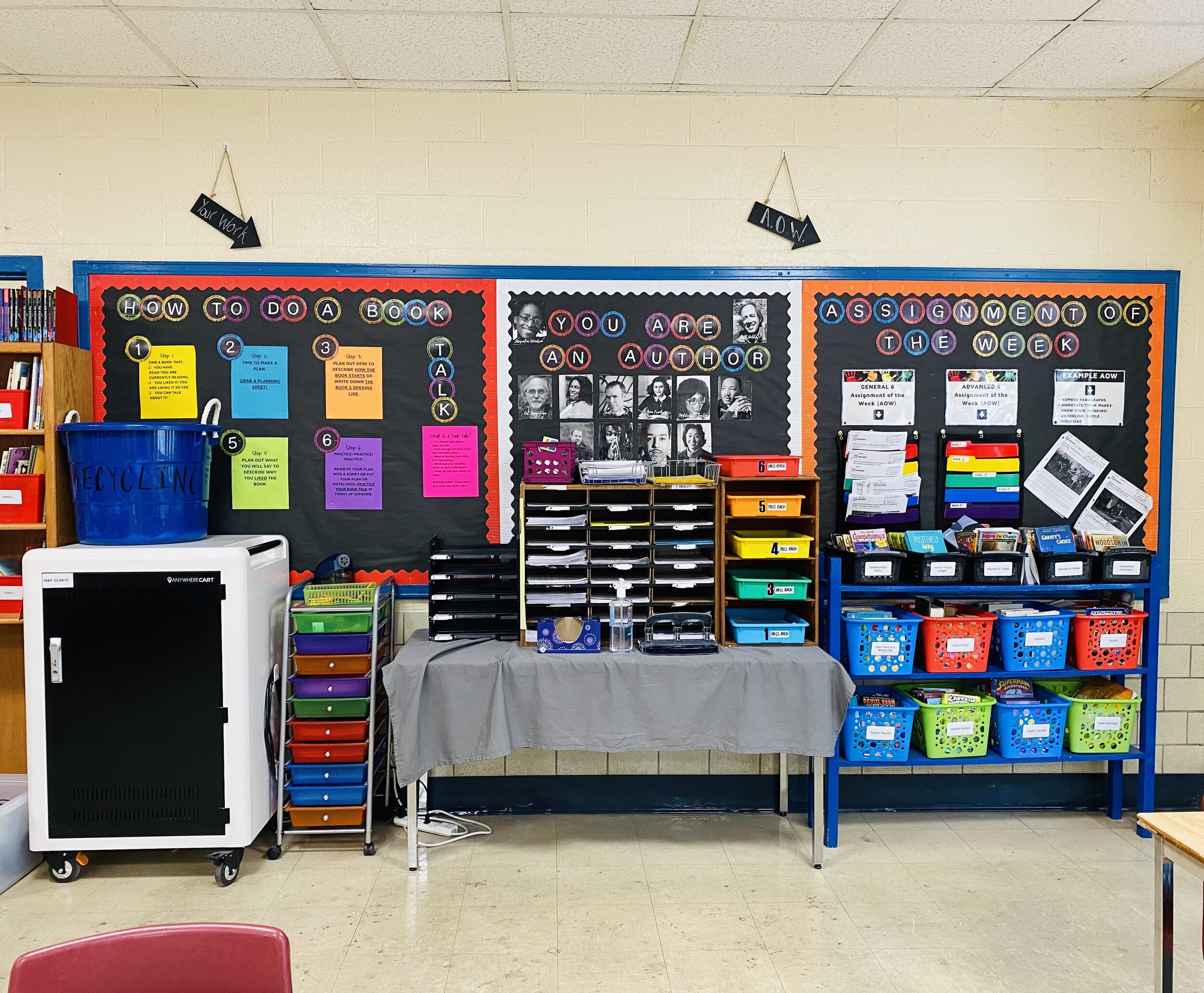
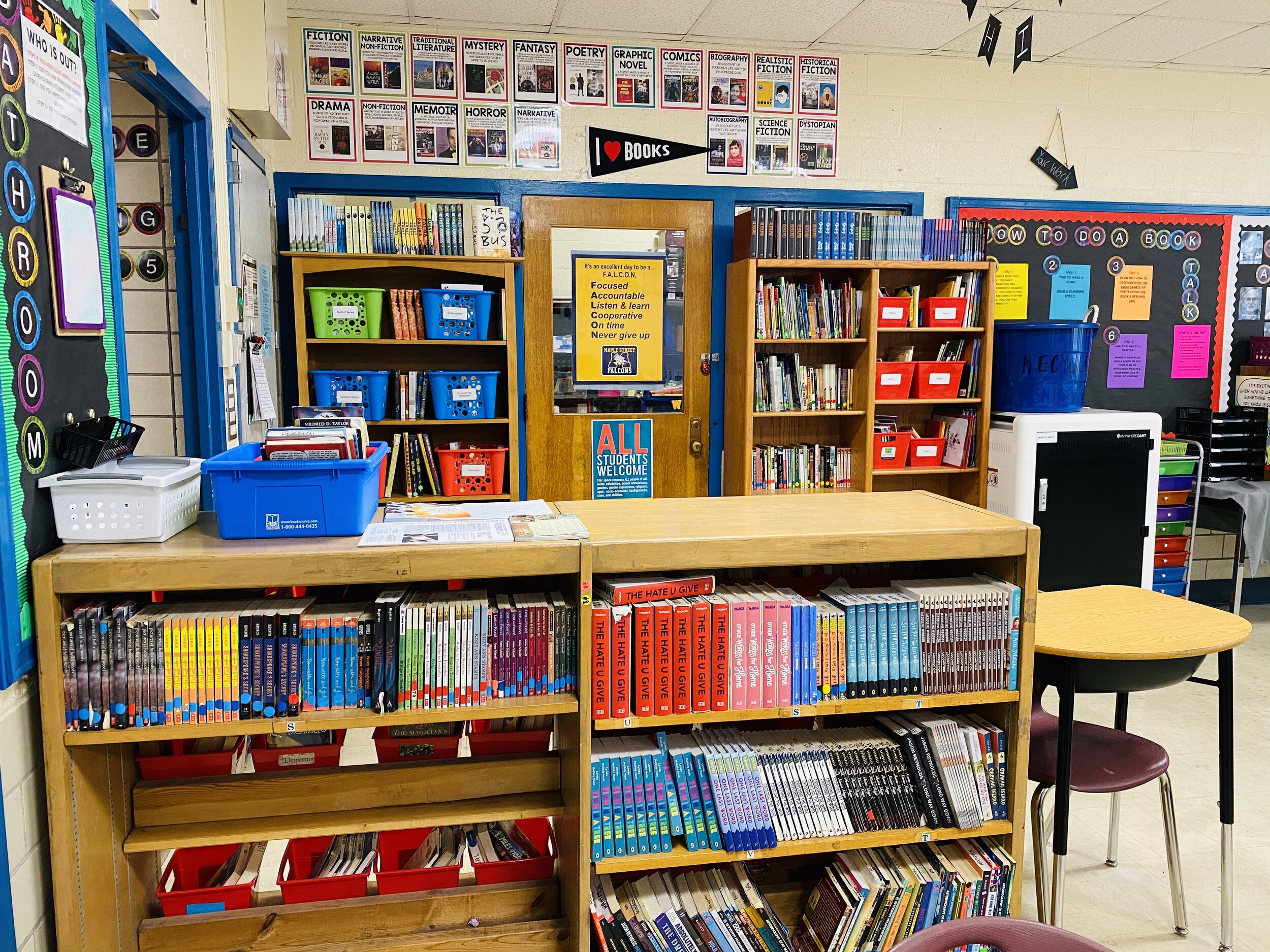

How do I set up instructional routines at the beginning of the year?
My plan for starting the school year has been pretty consistent in the past few years. I want to start by showing how to use our classroom space, focusing on student voice and effort, and showing them the power of reading and writing right away. I don’t do anything that is the deliberate instruction of “how to behave” or “how to act.” I use content to teach my students about life, and this includes how to adhere to school and classroom expectations. I teach sixth-graders, so they are hesitant about everything from schedules to lockers. My first-week schedule this past year looked like this:
WEEK ONE SCHEDULE AT-A-GLANCE:
DAY 1: Attendance Would You Rather Game, Hand Out Maps/Schedules, Distribute Team Welcome Letter
DAY 2: Read Aloud-The Day You Begin by Jacqueline Woodson, Writing Into the Day Opinion Prompt, Introduction Prezi with Room Tour, Distribute Syllabus and Family Letter Assignment








DAY 3: Read Aloud-How to Read a Book by Kwame Alexander, Class Brainstorm Why Does Reading Suck/Why is Reading Great, Group Story Brainstorm, Group Draft, Writing Endings
DAY 4: Read Aloud-The Word Collector, Writing Into the Day Opinion Prompt, Friday Free Write Activity, Kahoot (Expectations/Syllabus Review)
Now that you have seen my quick schedule, let me talk about the routines that are embedded within each day.
Voice, Effort, and Physical Space
Right away, I want all students to feel heard. When I do “would you rather” attendance, I get every voice in the room on the first day. We make schedules and take a tour of the building. I want them to feel at ease in a new place. We get a chance to establish how we walk in the hall, how we listen to each other when we ask a question, and how we handle materials when we clean up for the day. I want them to learn that effort is what matters, not exactly getting it right. I am simultaneously trying to do activities that allow them to speak and then showing them how we do business in this classroom. Everything moves from a place of kindness and respect.
Reading is Love. Explore Books.
Reading is a routine that students need to hear about. Sometimes they come with a love for reading that is deep, and other times they have lost their way when it comes to their relationships with reading. We start where they are. However, they need to understand that their love for reading comes first. I love using picture books as read alouds because they identify with this transition from elementary school. I then ask them a question about their opinion (voice) and hand them information about the class in the form of a syllabus. My syllabus asks for a family letter each year. I want the families to tell me more about the students. With up to 158 students on my teaching load each year, I need a running start if I plan on getting to know my students.
Write Your Voice.
We start a routine that will carry us throughout the year right away called Friday Free Write. I let them write about anything they want. They can use a prompt I provide or make a crazy story up out of nowhere. Then, we share. Sharing is the most important part of this routine because students get hooked on stories. The power of stories helps to hold up any beginning of the year routine in any subject area. It is why I start the year in my curriculum with personal narrative stories. I want to hear their voices tell their own stories. Zaretta L Hammond reminds us in her book Culturally Responsive Teaching and The Brain: Promoting Authentic Engagement and Rigor Among Culturally and Linguistically Diverse Students: “Turns out that storytelling is one of the universal ways people connect and get to know each other around the world. The human brain is hardwired for stories...For example, when we tell stories to others, the brains of the people listening synchronize with the storyteller’s brain.” Stories are the main ways we should be establishing routines in the beginning of any school year or class.
Where do I find books for my classroom library?
I included this question because everyone should have a classroom library. Donalyn Miller addressed the idea of “book deserts” across classrooms and buildings in her Nerdy Book Club blog post, “Desertification", “Many children—disproportionately children of color—live in book deserts without meaningful access to books in their schools or communities. Differential book access affects the level of education children attain, which has long-term consequences for their health, productivity, and quality of life. The plight of rural and urban book deserts must be addressed before we see significant growth in American school children’s performance on standardized tests. Instead of spending money on things that don’t work, why don’t we spend it on books and do everything we can to get these books into kids’ hands?” We have to have books in our classrooms. Yet, they are also expensive. I created a list of places to get books into my classroom without paying out of my own pocket.
Brainstorm of Where/How to Get Books
Organization and Checkout Systems
How do I build positive relationships in my classroom?
Positive relationships start from a place of positivity. As Rita Pierson said in her TED Talk, “ You know, kids don't learn from people they don't like.” It is true. Even though we don’t want to be our students’ best friend, we do want our students to like us. Like equates to trust, belief in academic ability, and respect. You just so happen to need all three of those for positive classroom engagement as well. If students feel like they are safe and liked, they will be more open to instruction.
Greet students at the door
Say student names as much as possible. Names are linked to identity.
Establish contact with each student as much as possible. With class sizes of 35 and more, we need to make each child that comes into our classrooms feel seen.
Facilitate the sharing of work and voices being heard in the classroom
Give positive shout-outs to students who are doing great work
Reward and recognize kindness
Get knowledgable about culturally responsive teaching as a mindset, not necessarily a set of strategies
Read:
How do I really prepare for behavior and classroom management?
Observe
I love talking about classroom management because the best experience is on-the-job observation and scenario training. The best advice I can give to a pre-service teacher is to get into a classroom-any classroom-and observe the situations that come up in day-to-day instruction. You can see how different teachers model different situations. You may disagree with how a teacher handled an issue, but now you have a formed opinion about a scenario in class. Your task is to create an arsenal of reactions when you have your own classroom. It creates major confidence when you know how you will respond to certain situations. This could be a physical altercation or a verbal exchange between two students. We don’t always handle everything as perfectly as possible, but the knowledge of how to respond to a variety of situations creates a mental acuity that cannot be easily replicated. Each teacher has their own style of classroom management. You will most likely try to emulate your mentor teacher because that was the example given to you. I would continue to urge you to see other classrooms to get a sense of what feels like you.
Time
Besides observation, the best advice comes from a place of time. Behavior and classroom management issues are handled best as fast as possible. Time is your actual enemy when it comes to classroom management. The best way to resolve conflict in the classroom is to handle the issue as quickly as possible. More time equals an argument and a drawn-out issue. I find sometimes that when I observe other classrooms, the teacher may make the issue longer than needed. Address the behavior and then insert choices for a response. If the student doesn’t respond, they are offering a choice for the involvement in the situation. Situations handled quickly leave room for love and respect while longer situations make it feel like it is a personal attack.
Choice
Choice theory is key in not damaging positive relationships in the classroom. I like to address the concern, and then offer students a choice for behavior. There are lots of power plays in the choices that you give. It would be nice if the student chose to respond to the desired behavior at all times, but they don’t. There are different types of behavior that can insert themselves into the choices we give students. Sometimes we choose to ignore avoidance behaviors and sometimes we need to address behaviors with more options for consequences, rather than reset choices. Again, start building scenarios to figure out how you would respond to different situations.
Disruptive behavior (Student won’t comply, and disrupts others)
Avoidance behavior (Student won’t comply, but does not disrupt others)
Desired behavior (What student should be doing)
Reset choice (Go to the bathroom, get a drink, check-in with another adult, run an “errand” for you, help in class in some way, etc)
Consequence choice (Phone call home, behavior room, administrative office, etc)
Relationship Building
I use my cell phone a lot in my classroom. This is a major personal preference that not all teachers feel comfortable within their first years, let alone their more tenured years in teaching. It is a matter of your level of comfort. I love making positive phone calls and texts home to families, and I love having the ability to form relationships with parents and guardians when I need them to be on my side during a difficult student interaction. I find that sometimes families need a reliable outlet at school when they are concerned about their child, and in turn, I can reach out to them if needed to help resolve a classroom dispute or situation. Being able to factor in parent involvement in choice changes the game for classroom management and building rapport with families.
Read: “Make Your Classroom Better By Understanding the Four Types of Motivation”
How do I avoid burnout?
Burnout is going to happen. With more and more teachers leaving the profession, self-care and wellness is something that has taken over the topic of every pre-service program and teacher conference. Anxiety, stress, and depression are at an all-time high in this profession. However, we can battle stress and burnout when it comes to teaching when we employ a variety of self-care tools during our workweek and weekend. I focus on six different areas of self-care that are important to consider:
Physical (Yoga, sleep, mindful eating)
Emotional (Morning journaling, drawing, creating,)
Spiritual (Reading, meditating, breathing)
Intellectual (Blogging, writing, listening to podcasts, etc)
Social (Work is done by 8 pm, saying “no” more to obligations)
Sensory (Skincare, music)
Other people have other areas that they consider important, but these top six are what I circle back to when I am feeling burnt out. It all comes back to our allotment of time. You have to make time for what is important, and ultimately, you cannot be a great teacher if you are burnt out and tired. Focus on one area a week, take the sick days or mental health days, make sure you are getting enough sleep, and use physical wellness as a way to stay strong in teaching.
Read:
How do I make sure “next year” is better?
Develop a file system for reflection during this year in order to make next year better. Whether this is a bullet journal for keeping track fo reflections or a “next year” notebook, you should be keeping track of what goes right and wrong. You can even use your lesson plan hyperdoc in order to reflect, but the more you make notes now, the easier it will be to keep what worked this year and spend time revising the flops for next year. I started my teacher blog in 2017, and I wish I would have started right away to keep track of all of the reflections and ideas that came up over the years. Whatever method you choose, get into the habit of finding a mode of reflection wherever you go. If you go to observe a classroom, bring a notebook. If you read a teacher book, take the high notes away in a way that makes them usable for you later on. The organized new teacher is the wiser seasoned teacher.







